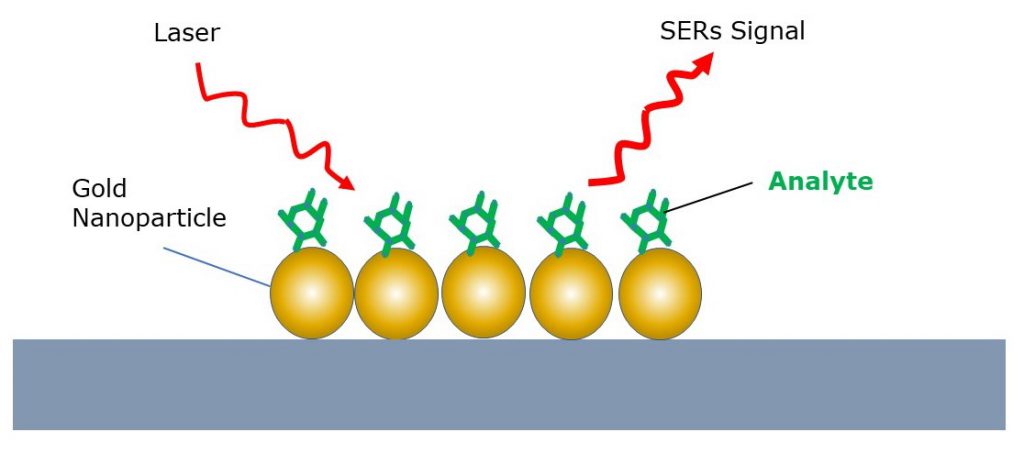Surface enhanced Raman spectroscopy is an extremely sensitive method of enhancing the Raman scattering of molecules supported by nanostructured materials. It means that structural fingerprinting of low concentration analytes is possible. This process is done through plasmon-mediated amplification of electrical fields or chemical enhancement.
In this article, we discuss how SERS works and its key applications.
What is Surface Enhanced Raman Spectroscopy?
Scattering of light by molecules can be either elastic (Rayleigh scattering) or inelastic (Raman scattering). The main difference is that in elastic scattering, the energy of the photon and the molecule’s state is not changed by the scattering events. This means that light scattered by the Rayleigh technique does not offer much information about molecular states and structures.
In inelastic scattering, monochromatic light frequencies change when they interact with the modes and vibrational states of a molecule. Raman spectroscopy has developed as an extremely sensitive method with the advancement of laser sources. However, the low-scattering cross-sections and resultant low sensitivity have limited the applications of standard Raman spectroscopy.

Surface enhanced Raman spectroscopy is a method that involves molecules undergoing higher scattering efficiencies when adsorbed on metal colloidal nanoparticles and rough metal surfaces.
How it Works
SERS uses metal surfaces roughened at the nanoscale, made from silver or gold. These roughened nanostructures are excited by lasers, increasing the surface charges and generating a localized plasmonic light field.
Molecules that are absorbed or are positioned closely to the enhanced field at the surface lead to an increase in Raman signal of many orders of magnitude. This increase in Raman signals can lead to detections of low concentrations without requiring fluorescent labelling.
Applications of Surface Enhanced Raman Spectroscopy
Illicit Drug Detection
SERS can be used to identify and detect some illicit drugs, such as Heroin, MDMA and Fentanyl. This is because it offers the capacity to create a highly specific molecular.. SERS can also identify more than one molecules at a time, which is particularly helpful for identifying the constituent parts of impure street drugs.
Pollution Monitoring in Water
Surface enhanced Raman spectroscopy is excellent for monitoring water quality and pollutant levels. SERS offers a highly sensitive, multi-capable means of non-destructive testing that offers insight into organic and inorganic pollutants in water.
Food Safety
SERS is a good choice for food inspection because of its sensitivity, readiness, and minimal sample preparation requirements. It can be used to detect pathogenic microorganisms present in foods, as well as food contaminants, such as Melamine and adulterations.
Pharmaceuticals
Pharmaceuticals are made up of several active ingredients with the levels of the actual drug being minuscule. This is why highly specific methods must be used for analysis and surface enhanced Raman spectroscopy is an excellent tool for this context as it can help understand the interactions between the compounds within the drug and the pathogenic germs and organisms.
Surface Enhanced Raman Sensors from Nikalyte
Nikalyte’s innovative SERS technology combines high sensitivity with low cost and ease of use. Nikalyte’s signature nanoparticle SERS substrates arehighly sensitive for use with analytes such as Fentanyl, caffeine, Amphetamine, and Heroin.
You can try Nikalyte’s surface enhanced Raman sensor substrates in your lab. Click here to find out more.
References
- https://www.nature.com/articles/s43586-021-00083-6
- https://www.intechopen.com/chapters/72277
- https://www.semrock.com/surface-enhanced-raman-scattering-sers.aspx
- https://doi.org/10.1016/j.talanta.2018.08.032
